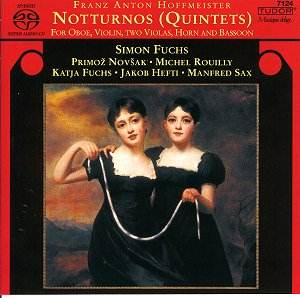I suppose Hoffmeister
is best known for his celebrated Viola
Concerto. But in his time he was as
well known for publishing as for composition
– his firm eventually transmuted into
C. F. Peters – though his prodigious
output was reflected in one hundred
quartets for flute and strings, a raft
of symphonic literature, long forgotten
stage works and the like.
These Notturnos, quintets
for winds and strings, are genial and
well crafted works but cut from the
easy listening, divertimento or tafelmusik
cloth. Looking through my notes I see
the words "agreeable" and
"loquacious" cropping up time
and again and that will give you a fair
indication of the pitch of these five
works. Hoffmeister at least had the
entertaining idea to score for violin,
two violas and the winds or, in the
case of Nos. 4 and 5 to dispense with
the violin altogether. It gives a warm
and mellow sonority to the voicings.
First movements feature good running
string figuration (No.1 in B) and slow
movements tend to veer very much to
Andantes or even Allegrettos than the
stated Adagio (No.1 again and Nos. 2
and 6 share this characteristic lightness
of declamation).
What he did possess
is a certain raffish grazioso element,
and it’s that that enlivens these quintets
and gives them some degree of personality
beyond the purely functional. The opening
of No.4 possesses it in abundance with
the oboe dancing over a warm string
cushion and the bassoon at the bottom
providing basic harmonic direction and
filling out the texture – pretty much
a safe description of most of these
works. Occasionally he will set a string
player free – as he does with the violin
in the slow movement of No.2, or he’ll
introduce a witty cadential passage
for the horn as in the Minuet of No.4.
It’s only in the slightly quizzical
harmonic implications of the opening
Adagio of the Divertimento-like No.5
that we can see Hoffmeister opening
up the pleasing detachment of these
works to explore other, more expressive
material. But it’s not for long.
These are effortlessly
genial works, attractively played, and
warmly recorded. Quietly humorous and
Mannheim-Mozartian in stylistic affiliation
they make for exceptionally undemanding
listening – as was surely the intention.
Jonathan Woolf


